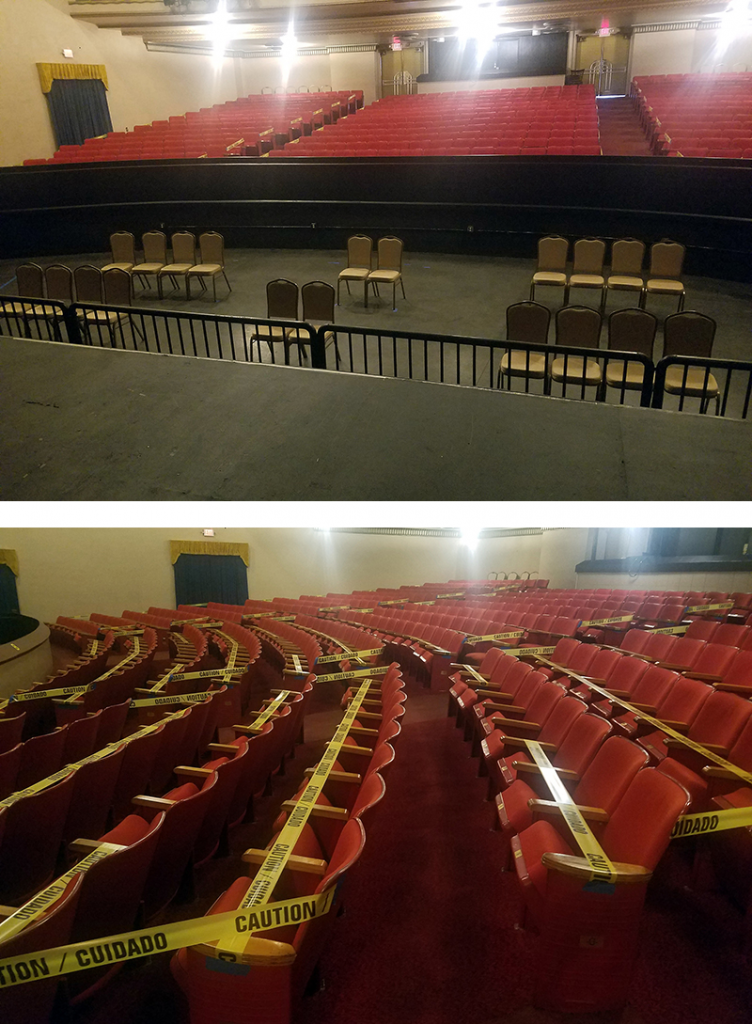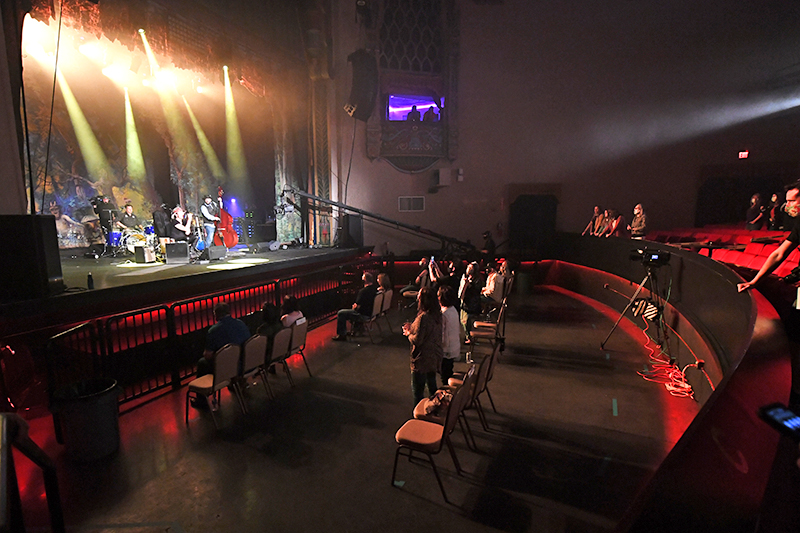On Monday, May 18, TempleLive in Fort Smith, AR hosted what is being considered the first socially distanced concert in the United States in the wake of COVID-19. The venue’s normal capacity of 1,100 was reduced to 20 percent, allowing 229 people to attend the performance by Bishop Gunn frontman Travis McCready. Besides the reduced capacity (which at time of press had been expanded to 30 percent), the TempleLive website provided an overall modified operation protocol.
After the show, I followed up with Mike Brown, TempleLive vice president of operations, and Lance Dierker, the venue’s production manager and also audio, video and lighting integrator at Audio/Video Designs in Oklahoma, for a conversation about the present realities of operating a concert venue amidst the lockdown. In 2014, the duo turned a hundred-year-old, 53,000-square-foot Masonic Temple building into a concert venue, with a strategy that prioritizes and streamlines the experience for the visiting artists and production staff, an approach that has left TempleLive well positioned to face the current production industry difficulties.
Michael Lawrence: Some of the guidance that we’re seeing here is reduced seating capacity – 20 or 30 percent of your regular seats. And I think one of the elephants in the room here is that for some shows, selling 20 percent of the seats means there won’t be a show because you’re losing money. Now, there were people in the room, but you were far under your regular capacity. How are you dealing with that?

Mike Brown: It relates to your expenses, really – talent costs, production costs, and labor model. We know what our production costs are; they’re relatively fixed. You’re going to have to rely on livestreams behind a pay window to increase your reach and generate revenue on that side, because bar sales are going to be negated – people are wearing masks, and they have to fight through that.
Hopefully, politics will get out of the way, science will be allowed to take over, and we’ll realize that you can get back to normal activity if you just wash your hands. Now the CDC (U.S. Centers for Disease Control and Prevention) has come out and said that this virus doesn’t really have a longevity on hard surfaces, so it’s about managing contact with someone who is actually shedding a virus, who may cough or sneeze, or something along those lines.
ML: Another one of the hurdles is that even if you open back up, at the end of the day, if people don’t want to come out and see a show, you’re stuck. Are you seeing people who are scared to come out? Or are you seeing people saying “I can’t wait to come out to the show?” How’s that look to you?

MB: Well, we played the May 18th show, and everyone who was there had zero fear. And we’re actively selling tickets – people really do want to get out and see a show.
ML: You have a seating capacity of 1,100 – what sort of working capacity do you have with the current constraints?
MB: The state of Arkansas has upped it to one-third capacity, which will put us at about 365.
ML: So you could do acoustic acts – I think that’s the kind of stuff that really makes sense in this reality –
MB: Well, I don’t think so, I think if bands can decide to leave all their stuff – go back to when you were 16 and you played in a garage band, and all you had was one guitar and one amp and a small drum kit and – maybe if you were fortunate enough to have a dad who played, you’d have an Ampeg bass rig, you know – you can leave all the stuff, you don’t need guitar techs and drum techs and all that. If you really want to play and really want to work, I think there are some artists who will get out and do it along those lines.

Lance Dierker: Obviously there’s a trickle down element to that, because it takes a lot of people to put on a show, and those people are getting hurt by that as well, all the way down to the stagehands, but the way we designed this venue – Mike and I have known each other for 30 years, and one of the goals was to create a venue that was easy to manage.
So when bands are on tour, they never know what they’re walking in to. But [at TempleLive] they walk in to plenty of power, plenty of PA, plenty of available backline if they want it, the push is 40 feet from the alley to the center of the stage. It’s so conveniently set up, even the larger bands we’ve had there, the production managers walk in and look around and say, “OK, we’re going to have an easy day.” And that was our goal – the first six months were spent convincing people to come [to Fort Smith], and after that, the reputation for the way the venue is set up, the way people are treated, availability of amenities and hospitality, it’s an easy venue to walk in and have a good day.
ML: That’s great to hear, and I think that makes a lot of sense, if it’s that much easier for you guys to get a show happening. I think it’s the companies and venues managing their overhead well, those are the ones who will get back on their feet first after all this.

In terms of the extra burden that you’re dealing with in terms of wiping the venue down, the sanitization, the changes to food and beverages that you have available – is that a minor inconvenience or a paradigm shift in terms of how you’re handling your front of house stuff?
MB: Well, we cross-trained our ushers and other people to do things to facilitate the extra hand sanitizing and those things, but the target keeps moving in terms of what this virus really is and what it’s capable of doing. I don’t think we’ll need to continue with the constant touch points being wiped because now the CDC is telling us it doesn’t have any efficacy on hard surfaces, so it will be a moving target.
LD: I was pretty impressed with the way that was handled because we didn’t have anyone misbehaving. I didn’t see anyone who wasn’t wearing a mask – the people who came out and wanted to be there were also being very responsible about it.
ML: And I think that’s a huge part of this – that the people who are coming out to shows are doing so responsibly, because they have a lot of control, I think, in how quickly we get things rolling again.
LD: And I’m speaking for Mike a bit too – he was quoted as saying, “We’re not doing this with a cavalier attitude, we know this exists.” There was life, now we have life plus COVID. Six months from now, we’re going to have life plus COVID, and we’re going to have to evolve. So if you choose to come do this, you will be monitored, your temperature is going to be taken, security is going to be watching, we’re going to be part of this, and we’re going to get through it together.
But we have followed the regulations as close as we possibly can – and even further in most cases – and the event went off just fine.













